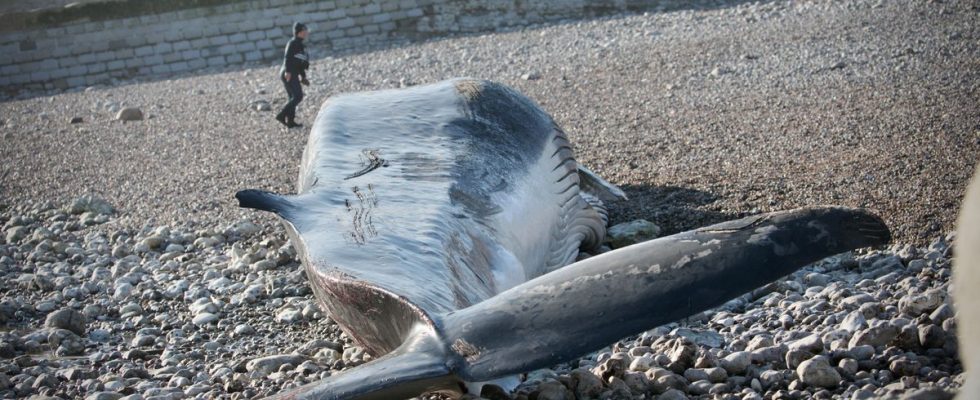Since April 19, the body of a fin whale weighing around thirty tons has been stranded on the Normandy coast. Prefecture and environmental associations are struggling to agree on the future of the carcass, in particular for the safety of fishing boats and swimmers. 20 minutes make the point.
Where is the cetacean located today?
The body of the whale was first beached on April 19 in Saint-Valéry-en-Caux, in Seine-Maritime, before being swept away by the tide. He reappeared on April 24 in Veules-les-Roses, a handful of kilometers further east. Usually, scientists are mobilized at each stranding to document them and collect scientific data. But the location of the cetacean, “at the foot of a 60-meter cliff”, makes any intervention “too risky”, indicated the Seine-Maritime prefecture in a press release dated April 28.
State services such as environmental associations therefore hope that a new tide will dislodge the body of the cetacean. The tidal coefficient conditions are met from May 3 to 8, indicates the NGO Robin des Bois. Contacted by 20 minutes this Friday, the association confirmed to us that the body was still at the foot of the cliff, but that a “natural release of water could occur in the hours and days to come”.
What future for the carcass once released?
Admitting that a new tide carries the body away, the prefecture had planned “to take a few samples from the carcass at sea”, Robin des Bois said in a press release on May 3. Far from the full examination usually carried out. The carcass then had to be equipped with a GPS beacon to ensure “monitoring of the corpse at sea, to inform of its presence and prevent possible collisions”, according to the prefecture.
A scenario opposed by the NGO Robin des Bois, which considers “more reasonable to tow it to a beach”. The arguments of the association seem to have been heard. According to the latest information from the NGO, contacted by 20 minutes this Friday, “the controlled drift option has been abandoned” and the carcass could well be the subject of an “attempt to tow”. “It’s good news,” rejoices Robin des Bois. Contacted by 20 minutesthe prefecture of Seine-Maritime has not yet responded to our requests.
Why could “controlled drift” be dangerous?
Beached for two weeks already, the carcass of around thirty tonnes could take several weeks to several months to decompose. In the meantime, the corpse risks remaining adrift in the waters of the English Channel. “A whale carcass behaves like an inner tube inflated with methane, ammonia and hydrogen sulfide,” warns Robin des Bois in its press release. A risk for fishing boats, but also for tourists this summer if the corpse were to “burst into bathing waters” despite GPS monitoring.
Worse, during the decomposition, the geolocation device could “dissociate itself from the corpse of the whale”, which could then “be drawn into the suction channel of the cooling waters of the nuclear power plants of Paluel and Penly”, fears long. So many reasons to favor a tow on a beach, which would also make it possible to carry out the usual complete post-mortem examination.

